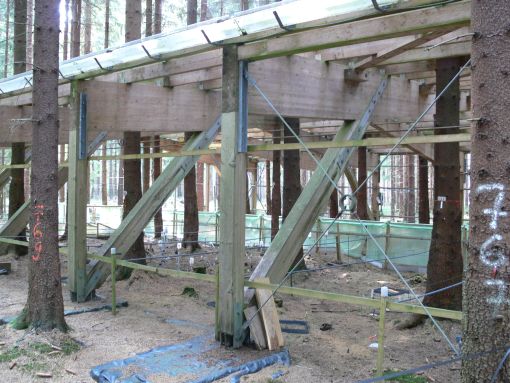Relating N transformation and transport to microbial activities in forest soils
Within the biosphere, nitrogen, a key element of living systems, undergoes a
complex transformation cycle essentially driven by microorganisms. While some transformation steps such as atmospheric N2 fixation
require specialized bacteria, others (i.e., primary attack of N bound to organic matter) involve a wide diversity of bacteria and fungi.
Although terrestrial habitats only occupy 1/6 of the earth’s surface, their soils play a major role for global N-cycling. Soils represent a
heterogeneous medium offering a wide spectrum of micro-niches with variable energetic, trophic, humidity, redox, and pH conditions that
harbour the different processes of the N-transformation cycle and the specific groups of involved microorganisms. This complex is variable
both in time and space. In this context, in situ monitoring of N-transformations in soils at a fine scale was technically impossible for long
time. And as soil microorganisms are still uncultivable and may display physiological artefacts once in culture, experimental approaches
in microcosms tend to give biased results. Additionally, as sum parameter techniques only quantify the balance between reactions that
may operate in opposite directions such as nitrification vs. denitrification they give no real information upon effective processes and their
intensity. A great step forward in the quantification of gross rates as well as in the identification of processes is the use of stable
15N isotope dilution techniques. In particular, substance specific isotope analysis on organic soil constituents provides
valuable information about the flow paths of nitrogen within the soil system.

Our approach
At another level, molecular biological methods principally allow revealing, localizing and even quantifying N transformation processes at fine scales. While PCR and DNA enables to enlighten the structure of microbial communities, RT-PCR on RNA opens perspectives for monitoring expression of specific genes encoding enzymes involved in N-transformations. However, due to the heterogeneous patchy structure of soils, the amount of analyses to perform for reaching adequate data sets for soil ecological interpretation is out of order with the high time and financial input to invest.
Therefore, we aim to (i) integrate N-transformation analyses and soil microbial investigations with molecular biological analyses at both the structural and functional levels, and (ii) in the latter investigations, to bridge classical PCR techniques by the development and assessment of pilot biochips.
A prerequisite of the study site was that basic ecological and ecosystems parameters were available. Therefore, we have chosen the experimental site instrumented by the University of Göttingen (Forschungszentrum Waldökosysteme) at the Solling.
At the moment we complement the available set of laccase gene sequences with our soil samples gathered at the Solling field site of the project. We will design a chip in cooperation with the group of G. Rambold (Bayreuth) to trace the diversity profile of fungal laccases at the site.
For further questions, please contact:
Susanne Theuerl, francois.buscot@ufz.de
